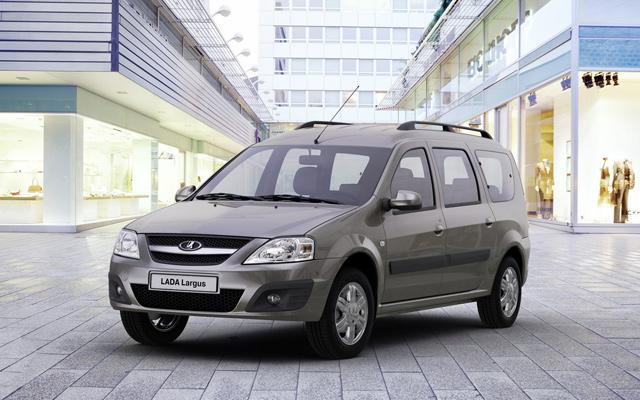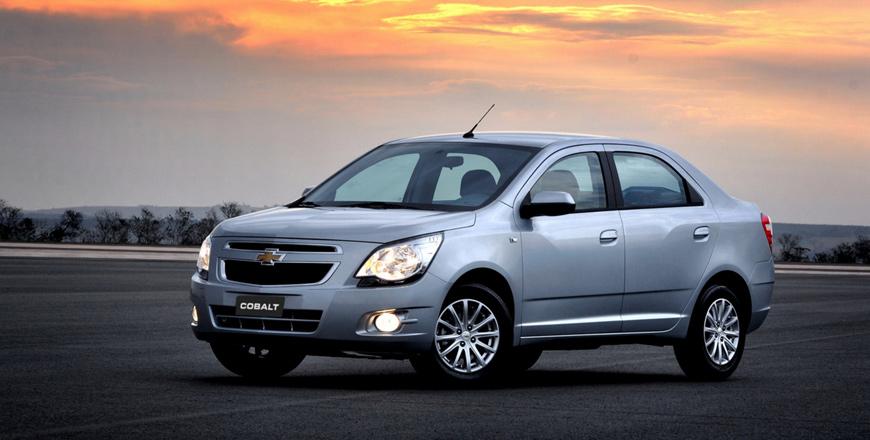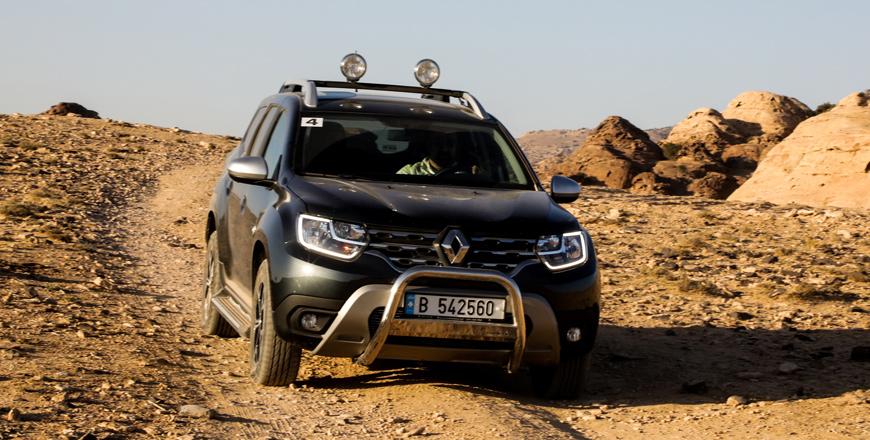You are here
Lada Largus Universal: Practical and comfortable people carrier
By Ghaith Madadha - Jun 04,2018 - Last updated at Jun 04,2018

Photo courtesy of Lada
A newcomer to the local market since Lada’s Jordanian comeback late last year, the Lada Largus Universal is practical, affordable, manoeuvrable and versatile people mover. First launched in 2012 as part of a new generation of cars developed by the Russian manufacturer as part of its association and in collaboration with the Renault-Nissan Alliance, the Largus is a modern design that is built for purpose rather than excess.
Fitted with the more necessary modern amenities and comforts, it is, however, designed to be trim, rugged, easy to maintain, accessible and functional.
Russian with French accent
Ostensibly a successor to the 1998-2006 Lada Niva-based four-wheel-drive Nadezhda multi-purpose vehicle (MPV), the Largus is based on a longer front-drive version of a Renault-Nissan platform widely used for various hatchbacks, saloons, SUVs and MPVs across Alliance associated brands including Nissan, Renault, Dacia and Lada. Offered in 7-seat MPV Universal model, as driven, or panel van versions in Jordan, the Largus is compact, narrow and easy to manoeuvre, but with a visibly long wheelbase, short overhangs and tall roof, it delivers both driving stability and generous 3-row cabin space.
Appearing longer than its 4470mm, the Largus Universal is styled with smooth, flowing lines and a sense of discretion, and being one of the earlier of Lada’s new crop of cars, lacks the brand’s more recent models’ sculpted side surfacing design trademark. Bearing resemblance to the Dacia Lodgy and Dokker MPVs and other Renault/Dacia compact saloons from front view, the Largus’ long wheelbase and cabin allow for long rear doors with easy access to the rear two seat rows. A subtle design, the Largus’ boot features unequal dual side hinged doors flanked by vertical rear lights.
Accessible ability
An honest and practical people mover, the Largus Universal is powered by a similarly unpretentious but suitably capable 1.6-litre 16-valve 4-cylinder engine, mated to a 5-speed manual gearbox driving the front wheels. Developing 100BHP at 5750rpm and 107lb/ft torque at 3750rpm, the 1370kg Largus accelerates through zero-100km/h in a decent 13.5 seconds, but its rate of acceleration to 80km/h seems quicker and allows one to join highway traffic at a timely pace. Capable of 165km/h top speed and smooth, capable and responsive at highway speeds, the Universal also returns comparatively low 7.9l/100km combined cycle fuel consumption.
Frugal for any 7-seater, the Largus’ engine and gearbox are well suited, with ratios optimised for performance and efficiency. Refined in operation, its engine isn’t exactly sporty or eager to race to redline, but is nicely progressive and consistent in delivery from idling to rev limit. Perkier when lightly loaded, one, however, compensates by holding gears longer when the Largus is heavily loaded. Effortlessly light, smooth and user-friendly for fingertip shifts and light, intuitive clutch pedal pick-up, the Largus shift action is slightly notchy if roughly handled, but isn’t quite as satisfyingly mechanical and connected as the Lada 4x4’s.
Supple and nimble
Seeming docile, soft and a little distant at first due to its light effort controls, the Largus is, however, a more talented handling car than one would expect. Driven with more enthusiasm, it soon reveals an agility and sense of involvement not too removed from the nimble and fun previous generation Renault Clio, to which it is loosely related. Through winding corners, the Largus’ light steering — aided by slim 185/65R15 tyres — weighs up nicely and becomes more communicative in feedback and precision. Meanwhile, some body lean is evident through corners, but settles in a progressive and predictable manner.
Long, slim and tall, the Largus may not immediately seem nimble handling, and especially not if one pushes too hard and steers in too late, where its long wheelbase tends to lend itself to an instinct to understeer. However, with early and sharp turn-in, and by pivoting its weight to the rear and outside, the Largus becomes surprisingly agile and eager pouncing between one corner to the next. Soon developing a rhythm to its driving style, one soon appreciates its supple suspension and tall tyres, which smooth out most imperfections with a velvety quality, and are forgiving over jagged and sudden ruts and bumps.
Practical and spacious
Developed with developing markets and rougher roads in mind, the Largus is comfortable and absorbent, while its long wheelbase and suspension settings keep it alert yet settled at speed and over large bumps and on rebound. Practical and spacious in a compact package, the narrow Largus easily negotiates tight backroads, while a relatively high 145mm ride height counters its long wheelbase on break-over and provides good clearance on semi-paved roads. Spacious inside with its high roof, its cargo capacity increases from a useful 135 litres with all seats up, to a generous 560 litres and a massive 2,350 litres when the second and third rows are folded down.
Convenient and flexible, the spacious Largus airy cabin features a big glasshouse for good visibility and big rear doors for easy third row access. Its cargo door windows are, however, somewhat higher, but its low loading height is notably useful. Inside, middle row passengers have an overhead storage compartment. Driving position is well adjustable and comfortable, but higher seat side support would be welcome when driving through corners.
Big on value, the Largus’ cabin is logically laid out and uses mostly decent quality, but not extravagant materials, yet also features a number of creature comforts including but not limited to a USB-enabled sound system, electric front and middle row windows and AC. Priced competitively at JD16,500, on the road with third party insurance, the Largus comes with a 3-year warranty including a 60,000km parts and labour service package and unlimited mileage roadside assistance.
TECHNICAL SPECIFICATIONS
Engine: 1.6-litre, transverse 4-cylinders
Bore x stroke: 79.5 x 80.5mm
Valve-train: 16-valve, DOHC
Gearbox: 5-speed manual, front-wheel-drive
Final drive: 4.2:1
Power, BHP (PS) [kW]: 100 (102) [75] @5750rpm
Specific power: 62.6BHP/litre
Power-to-weight: 73BHP/tonne
Torque, lb/ft (Nm): 107 (145) @3,750rpm
Specific torque: 90.8Nm/litre
Torque-to-weight: 105.8Nm/tonne
0-100km/h: 13.5-seconds
Top speed: 165km/h
Fuel consumption, urban/extra-urban/combined: 10.4/6.4-/7.9-litres/100km
Fuel capacity: 50-litres
Length: 4,470mm
Width: 1,750mm
Height: 1,670mm
Wheelbase: 2,905mm
Track, F/R: 1,469/1,466mm
Minimum ground clearance: 145mm
Cargo volume, behind third/second/first row: 135-/560-/2,350-litres
Unladen weight: 1,370kg
Gross weight: 1,850kg
Towing capacity, unbraked/braked: 650/1,300kg
Suspension, F: MacPherson struts, anti-roll bar
Suspension, R: Semi-independent, torsion beam
Steering: Power-assisted rack and pinion
Brakes, F/R: Discs/drums
Tyres: 185/65R15
Price, on the road: JD16,500
Related Articles
Hardly the first affordable and compact yet capable SUV, the Renault Duster nevertheless proved hugely popular in world markets, since it fi
The most popular car sold in Uzbekistan, where it is manufactured locally by the Uzbek-government’s and minority stakeholder General Motors’
A modern interpretation of a people’s car for the SUV and crossover milieu, the Renault Duster made the relentlessly popular “high-sided” ve


















